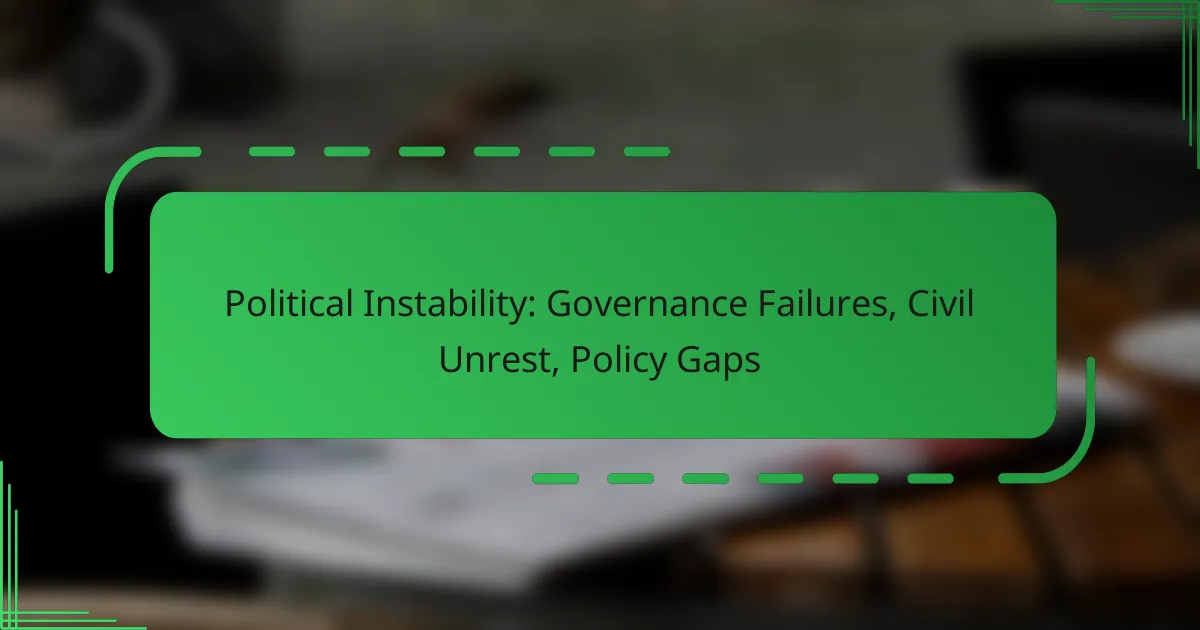Political instability frequently stems from a complex interplay of governance failures, civil unrest, and policy gaps, which can escalate societal tensions and lead to conflict. When governments neglect the needs of their citizens, public trust erodes, resulting in dissatisfaction and protests. Addressing these issues through effective governance strategies, such as decentralization and transparent policymaking, can foster accountability and community engagement, paving the way for a more stable political landscape.
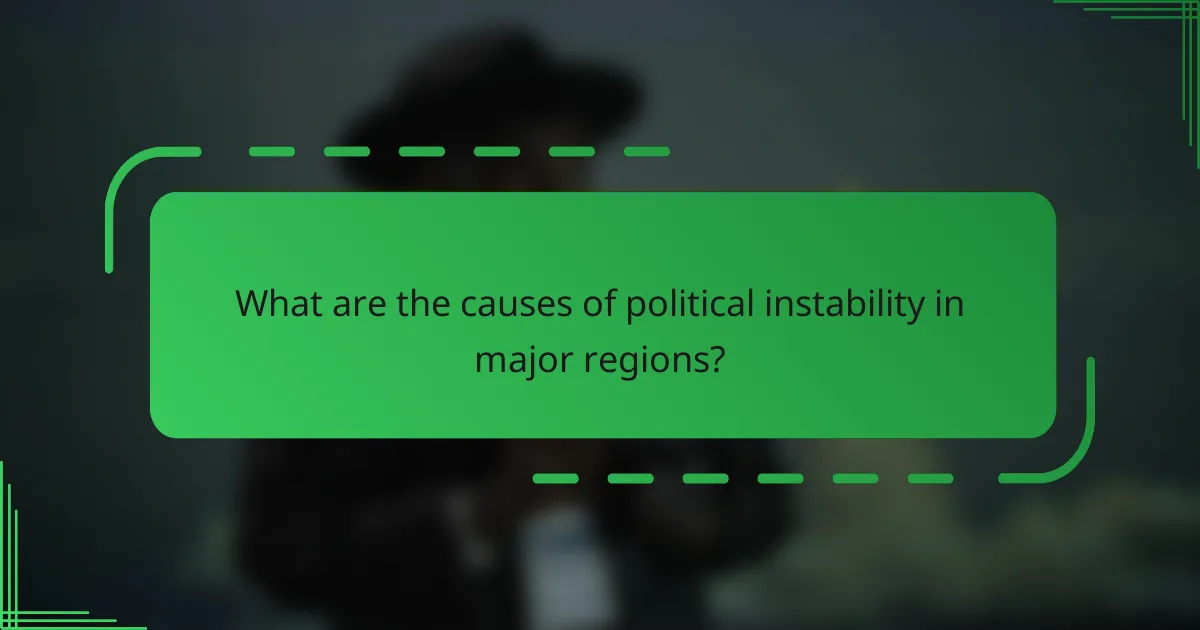
What are the causes of political instability in major regions?
Political instability in major regions often arises from a combination of governance failures, civil unrest, and policy gaps. These factors can create an environment where societal tensions escalate, leading to conflicts and disruptions.
Governance failures
Governance failures occur when political leaders are unable to effectively manage public resources, uphold the rule of law, or ensure accountability. This can lead to widespread corruption, lack of transparency, and erosion of public trust in institutions.
For example, in some countries, ineffective governance can result in inadequate public services, which may fuel dissatisfaction among citizens. This dissatisfaction can manifest in protests or calls for reform, further destabilizing the political landscape.
Civil unrest
Civil unrest typically arises from social grievances, economic disparities, or political repression. When citizens feel marginalized or oppressed, they may resort to protests, strikes, or even riots to voice their discontent.
Regions experiencing high levels of civil unrest often see a cycle of violence and retaliation, which can lead to further instability. For instance, in various parts of the Middle East and North Africa, protests against authoritarian regimes have sparked significant political upheaval.
Policy gaps
Policy gaps refer to the absence of effective laws or regulations that address pressing social and economic issues. When governments fail to implement policies that meet the needs of their populations, it can lead to frustration and unrest.
For example, inadequate responses to economic crises, such as unemployment or inflation, can exacerbate public discontent. Countries with significant policy gaps may struggle to maintain stability, as citizens demand immediate action and reform from their leaders.
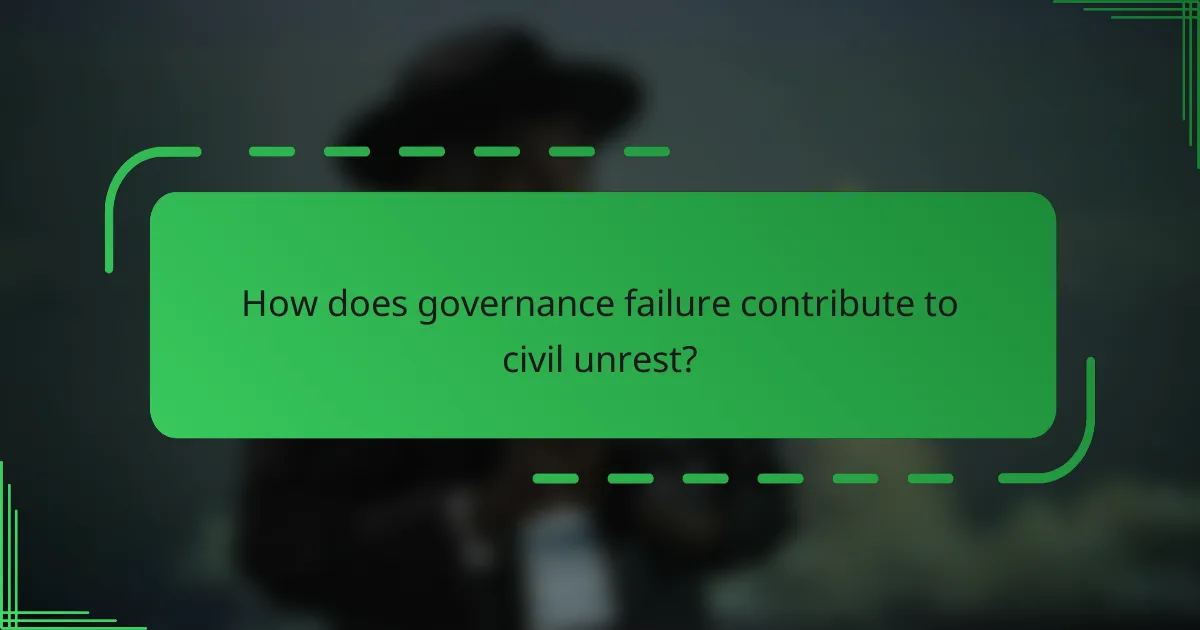
How does governance failure contribute to civil unrest?
Governance failure often leads to civil unrest by eroding public trust and creating a sense of injustice among citizens. When leaders fail to address the needs of the population, it can result in widespread dissatisfaction and protests.
Corruption in leadership
Corruption in leadership undermines effective governance and can trigger civil unrest. When officials prioritize personal gain over public welfare, it fosters a culture of distrust and resentment among citizens.
For instance, in countries where corruption is rampant, citizens may feel that their voices are ignored, leading to protests and demands for accountability. Transparency and ethical leadership are crucial to maintaining social stability.
Lack of public services
A lack of public services can significantly contribute to civil unrest by failing to meet basic needs. When essential services such as healthcare, education, and infrastructure are inadequate, citizens may mobilize to demand improvements.
In many regions, especially in developing countries, the absence of reliable public services can lead to frustration and protests. Governments should prioritize investment in these areas to mitigate unrest and foster a sense of community well-being.
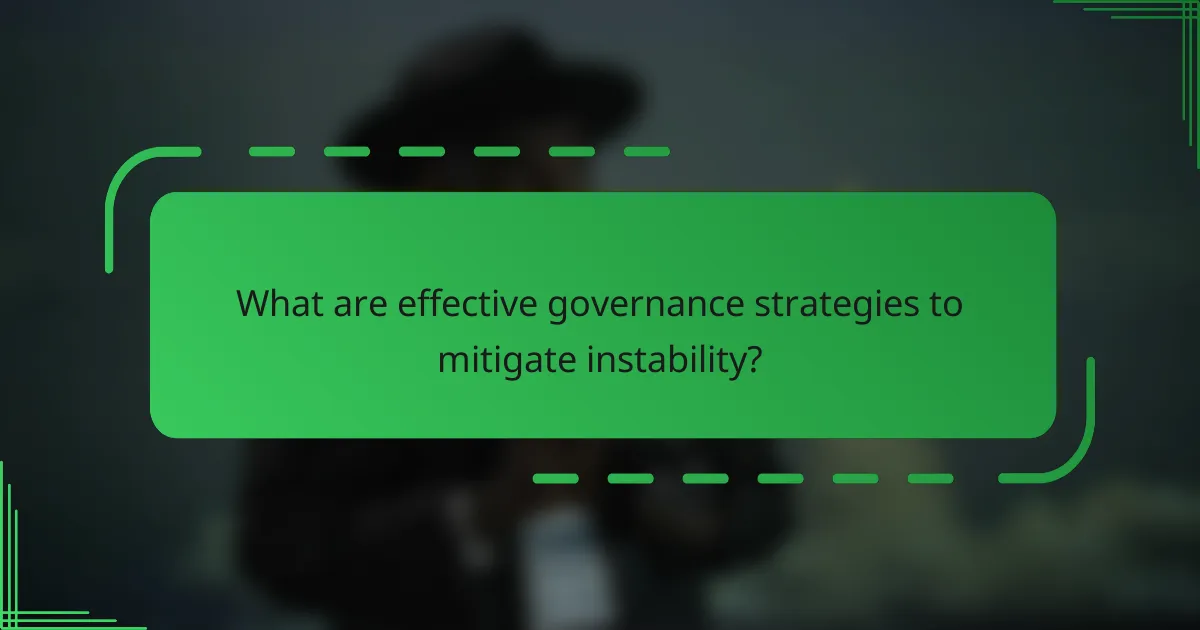
What are effective governance strategies to mitigate instability?
Effective governance strategies to mitigate instability include decentralizing power, ensuring transparent policy-making, and fostering community engagement. These approaches can enhance accountability, improve trust in institutions, and empower citizens, ultimately leading to a more stable political environment.
Decentralization of power
Decentralization involves distributing authority and decision-making closer to local governments and communities. This strategy can help address regional disparities and allow for more tailored responses to local needs. For instance, countries like Switzerland and Germany have successfully implemented decentralized governance structures that promote local autonomy.
When decentralizing, it is crucial to establish clear frameworks that define the roles and responsibilities of local authorities. This clarity can prevent power struggles and ensure effective collaboration between different levels of government. However, a balance must be struck to avoid fragmentation and maintain national cohesion.
Transparent policy-making
Transparent policy-making enhances trust in government by allowing citizens to see how decisions are made and resources are allocated. This can be achieved through open data initiatives, public consultations, and accessible reporting on government activities. Countries like Sweden and New Zealand exemplify transparency by providing citizens with easy access to information about policy processes.
To implement transparent practices, governments should prioritize clear communication and actively involve stakeholders in discussions. This engagement can lead to better-informed policies and increased public support. However, transparency must be balanced with the need to protect sensitive information to maintain national security.
Community engagement initiatives
Community engagement initiatives involve actively involving citizens in the decision-making process, which can enhance social cohesion and trust in governance. Programs such as participatory budgeting or town hall meetings allow residents to voice their concerns and contribute to local priorities. Cities like Porto Alegre in Brazil have successfully utilized participatory budgeting to empower citizens and improve local services.
To ensure effective community engagement, governments should adopt inclusive practices that reach diverse populations. This may include using multiple communication channels and providing resources in various languages. Additionally, it is essential to follow up on community input to demonstrate that citizen contributions are valued and considered in policy decisions.
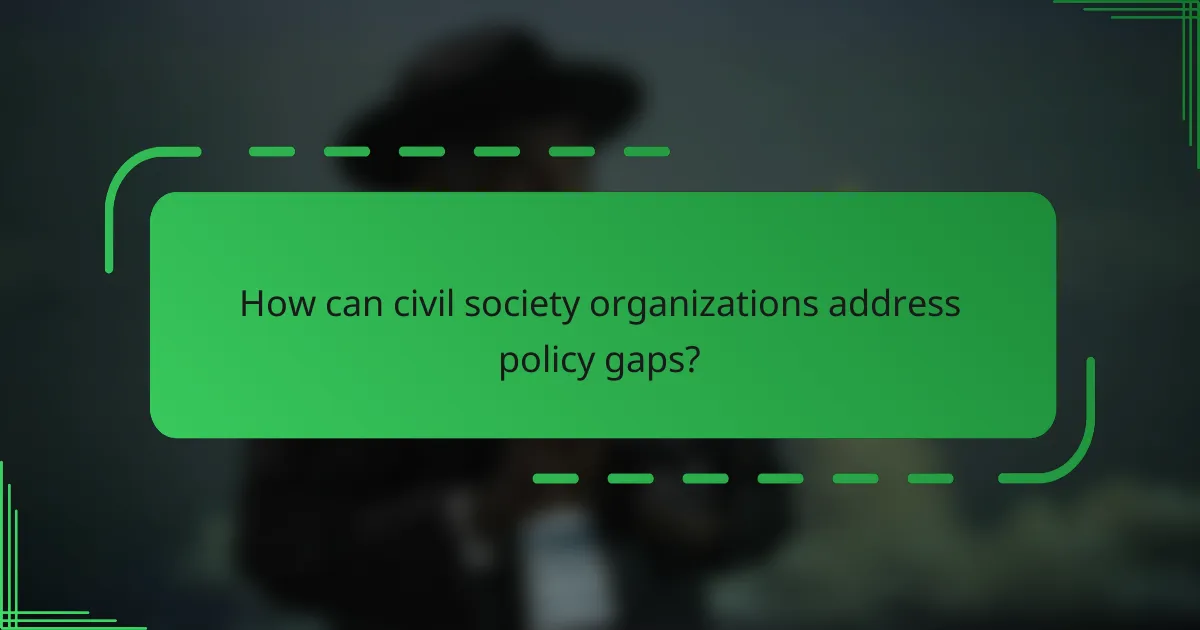
How can civil society organizations address policy gaps?
Civil society organizations (CSOs) can effectively address policy gaps by advocating for reforms and monitoring government actions. These strategies empower communities, promote accountability, and ensure that policies reflect the needs of the populace.
Advocacy for policy reform
Advocacy for policy reform involves raising awareness and influencing decision-makers to create or amend policies that address specific societal needs. CSOs can engage in campaigns, public discussions, and lobbying efforts to highlight issues and propose solutions.
Effective advocacy often requires building coalitions with other organizations, leveraging social media, and utilizing data to support claims. For instance, a CSO might gather community input on healthcare access and present findings to local government officials to push for improved services.
Monitoring government actions
Monitoring government actions is crucial for ensuring transparency and accountability. CSOs can track the implementation of policies, assess their effectiveness, and report on any discrepancies between stated goals and actual outcomes.
Tools such as public reports, citizen feedback mechanisms, and collaboration with watchdog organizations can enhance monitoring efforts. For example, a CSO might publish an annual report evaluating the government’s performance on education funding, highlighting areas where commitments have not been met.
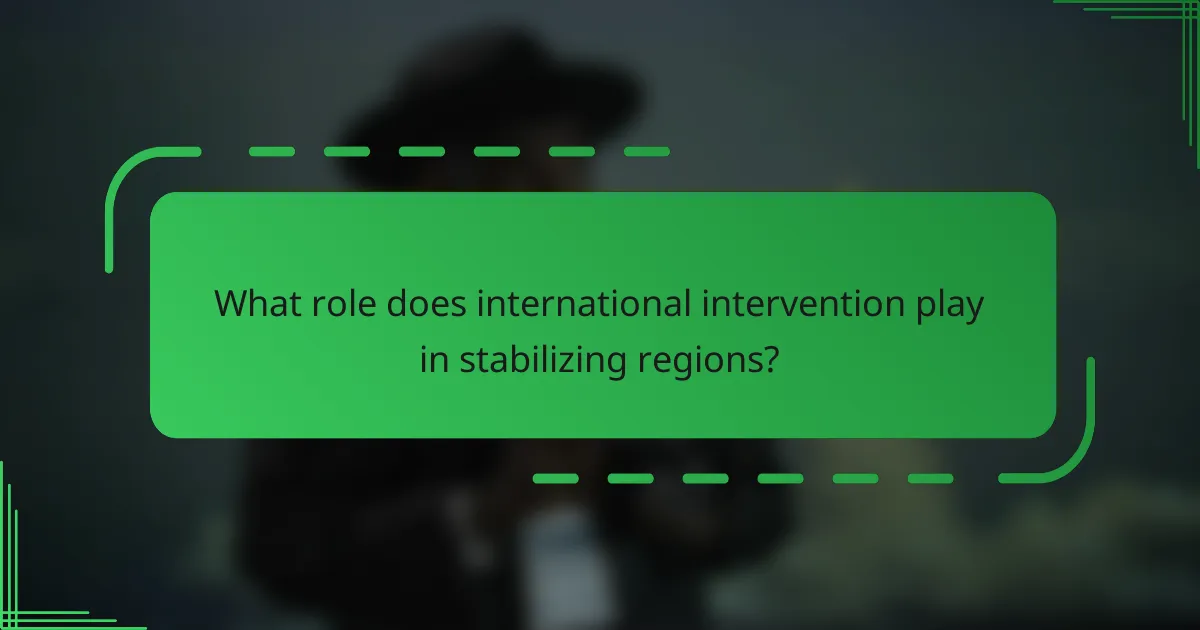
What role does international intervention play in stabilizing regions?
International intervention can significantly contribute to stabilizing regions experiencing political instability by providing necessary support through peacekeeping, economic aid, and diplomatic efforts. These interventions aim to restore order, promote governance, and address underlying issues that lead to unrest.
Peacekeeping missions
Peacekeeping missions typically involve the deployment of international forces to conflict zones to maintain peace and security. These missions often include troops from multiple countries and are mandated by organizations like the United Nations. Their primary goal is to create a secure environment for political processes and humanitarian efforts.
Successful peacekeeping requires careful coordination with local authorities and communities to ensure that the presence of foreign troops is accepted and effective. For instance, missions in regions like the Balkans or Africa have demonstrated that a well-structured peacekeeping force can help reduce violence and facilitate dialogue among conflicting parties.
Economic aid programs
Economic aid programs provide financial resources and technical assistance to stabilize economies affected by conflict or governance failures. These programs often focus on rebuilding infrastructure, supporting local businesses, and enhancing public services to foster economic growth and social stability.
Effective economic aid should be tailored to the specific needs of the region, taking into account local conditions and governance structures. For example, countries like Afghanistan and Haiti have received targeted aid to improve education and healthcare, which can help address root causes of unrest. However, it is crucial to ensure that aid does not inadvertently support corrupt practices or create dependency.

How do economic factors influence political stability?
Economic factors significantly impact political stability by affecting citizens’ livelihoods and their trust in governance. High unemployment and rising costs can lead to civil unrest and dissatisfaction with government policies, creating a cycle of instability.
Unemployment rates
Unemployment rates are a critical indicator of economic health and directly correlate with political stability. High unemployment can lead to increased frustration among citizens, resulting in protests or civil unrest as people demand better job opportunities and government intervention.
For instance, countries with unemployment rates exceeding 10% often experience heightened social tensions. Governments facing such challenges may need to implement job creation programs or economic reforms to stabilize the situation and regain public trust.
Inflation and cost of living
Inflation and the rising cost of living can severely affect political stability by eroding purchasing power and increasing public discontent. When essential goods become unaffordable, citizens may take to the streets to express their dissatisfaction with government policies that fail to address these economic pressures.
Countries experiencing inflation rates above 5% often see a direct impact on social stability. Governments must carefully manage monetary policy and consider subsidies or price controls to mitigate the effects of inflation and maintain political order.
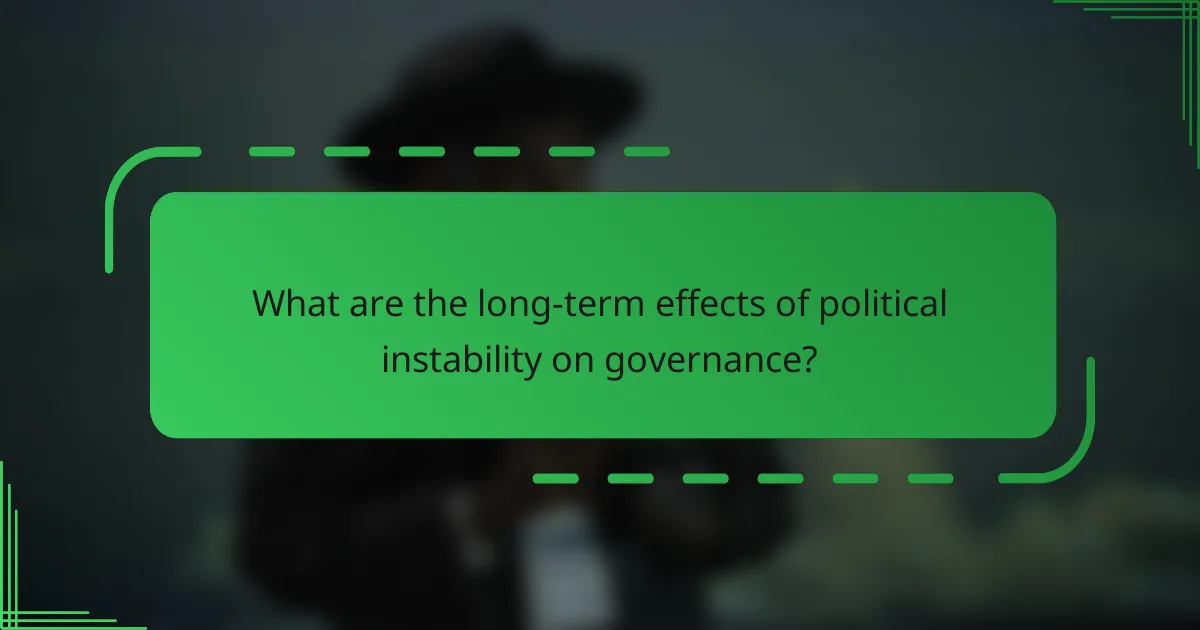
What are the long-term effects of political instability on governance?
Political instability can lead to significant long-term effects on governance, including weakened institutions, diminished public trust, and increased corruption. These consequences can create a cycle of instability that hampers effective governance and policy implementation.
Weak institutional frameworks
Weak institutional frameworks are a direct result of political instability, as they undermine the structures necessary for effective governance. When political systems are unstable, institutions may lack the authority or resources to enforce laws and policies, leading to a breakdown in order and accountability.
For example, countries experiencing prolonged civil unrest often see their judicial systems compromised, making it difficult to resolve disputes or uphold rights. This can result in a lack of public confidence in government, further exacerbating instability.
To strengthen institutional frameworks, governments should focus on building transparency and accountability measures. This includes implementing checks and balances, enhancing civic engagement, and fostering collaboration between governmental and non-governmental organizations.
